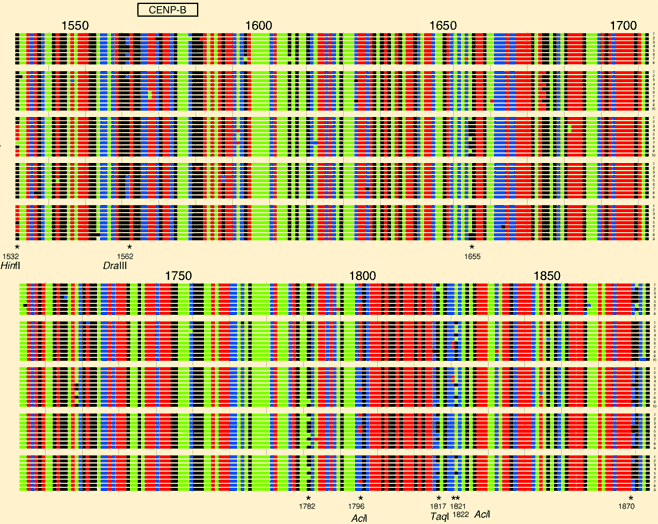Alpha Satellite DNA: Fast Intrachromosomal Conversion Mechanism
More than half of the human genome is made up of repetitive sequence elements, which, on an evolutionary time scale, do not follow Mendelian inheritance. For interspersed elements, such as alu or Line, transposition and (more importantly) gene conversion explains that the elements of a family evolve in concert. For centromeric tandem repeat arrays, the somewhat conservative model of unequal crossing over is often favoured ("conservative" because a special form of crossing over, which in principle is in accordance with the same processes known from Mendelian inheritance). The unequal crossing over hypothesis was mainly based on a computer simulation demonstrating that homogeneous tandem repeat arrays can be generated with a process solely based on mutation, unequal crossing over, and expansion (Smith,G.P., Science 1976).
Our study of sequence variation within a highly homogeneous tandem repeat array now suggests an important role of gene conversion at centromeres, too (Schindelhauer and Schwarz, Genome Res. 2002). In addition, conversion seems to be very fast, easily overriding other mechanisms known to efficiently drive the concerted evolution between homologs (of an individual and in the population).
Such a fast genomic turnover mechanism reinforces molecular drive and it's potential importance not only for genome evolution on the long term (Dover, Nature 1982, Trends in Genetics 2002), but also for present variability.
Genome Research Supplementary information
Dirk Schindelhauer, and Tobias Schwarz (2002) Evidence for a Fast, Intrachromosomal Conversion Mechanism From Mapping of Nucleotide Variants Within a Homogeneous alpha-Satellite DNA Array. Genome Res. 12: 1815-1826.
Supplementary figure 1 + 1
Supplementary figure 2 + 3
Supplementary figure 4 + 5
Sequence Information
Pairwise Comparisons (all sequences)
Pairwise Comparisons (365 pb overlap region)
Pairwise Comparisons (365 bp overlap of 9 arbitrary sequences)
Homology and Deviation Analysis
Satellite Tartan (example)
 | Centromeric tandem repeat arrays are highly homogeneous. The 1% variation can tell a lot about genomic turnover mechanisms ongoingly shaping our genome.
Four Color Sequence Alignment. A section of two 0.17 kb sized alpha satellite monomers derived from random 2 kb higher order repeat subclones of 5 unmapped PACs from a single DXZ1 alpha satellite array of a human X chromosome. Abundant variants were used to evaluate the relative impact of genomic turnover mechanisms on the maintenance and evolution of alpha satellite arrays. "Satellite tartans" display variation at a glance and will assist in interpreting contiguous sequences of tandem repeat arrays.
|
